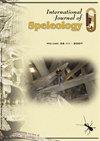Climate of a cave laboratory representative for rock art caves in the Vézère area (south-west France)
IF 1.3
4区 地球科学
Q3 GEOSCIENCES, MULTIDISCIPLINARY
引用次数: 0
Abstract
Leye Cave (Dordogne, France) is a laboratory cave in the Vézère area, a region that contains some of the most famous rock art caves in the world such as Lascaux, Font-de-Gaume and Combarelles, and is listed as Human World Heritage by UNESCO. Leye Cave was selected because it is representative of painted caves, with respect to parameters such as its geological stage, the presence of water and carbon dioxide, the geological state of its walls, and the size of the cave. These wall states are studied to better understand the conditions of conservation of rock art caves without damaging them. The choice of an equivalent medium, i.e., a non-painted cave, was made to be able to conduct experiments or take measurements that would not have been possible in a rock art cave. The climatic conditions (temperature, hygrometry, etc.) monitored since 2011 are central to our understanding of the genesis and evolution of wall states. Leye Cave is sub-horizontal then descendant, forming a cold air trap. The phenomenon of condensation is thought to be important in the genesis of these wall states. Our article presents a model which describes the competition that exists between the conduction of the rock heating the air and the convection cooling the rock, in the area named the “Throne Chamber”, located in the deepest parts of the cave.在vsamz地区(法国西南部)代表岩画洞穴的洞穴实验室气候
Leye洞穴(法国多尔多涅)是Vézère地区的一个实验室洞穴,该地区有一些世界上最著名的岩石艺术洞穴,如Lascaux、Font de Gaume和Combarelles,并被联合国教科文组织列为人类世界遗产。之所以选择乐业洞,是因为它在地质阶段、水和二氧化碳的存在、墙壁的地质状态以及洞穴的大小等参数方面具有绘画洞穴的代表性。研究这些岩壁状态是为了更好地了解岩石艺术洞穴的保护条件,而不破坏它们。选择等效介质,即非绘画洞穴,是为了能够进行岩石艺术洞穴中不可能进行的实验或测量。自2011年以来监测到的气候条件(温度、湿度等)是我们理解壁态起源和演化的核心。乐业洞是亚水平的然后后裔,形成了一个冷空气陷阱。凝结现象被认为是这些壁态发生的重要原因。我们的文章提出了一个模型,描述了在位于洞穴最深处的名为“王座室”的区域内,岩石加热空气的传导和冷却岩石的对流之间存在的竞争。
本文章由计算机程序翻译,如有差异,请以英文原文为准。
求助全文
约1分钟内获得全文
求助全文
来源期刊

International Journal of Speleology
地学-地球科学综合
CiteScore
3.10
自引率
23.10%
发文量
12
审稿时长
>12 weeks
期刊介绍:
The International Journal of Speleology has the aim to get cave and karst science known to an increasing number of scientists and scholars. The journal therefore offers the opportunity to all scientists working in and on karst to publish their original research articles or their review papers in an open access, high quality peer reviewed scientific journal at no cost. The journal offers the authors online first, open access, a free PDF of their article, and a wide range of abstracting and indexing services.
 求助内容:
求助内容: 应助结果提醒方式:
应助结果提醒方式:


